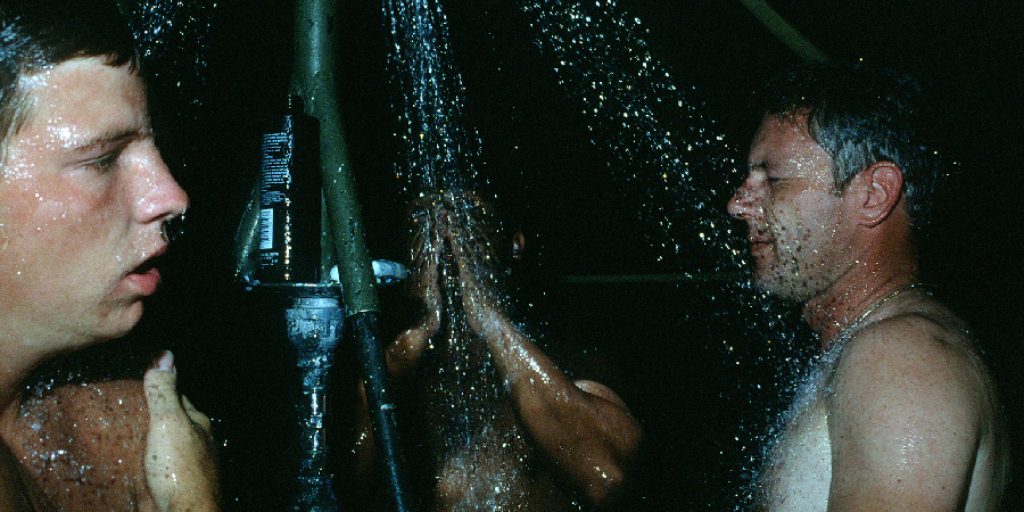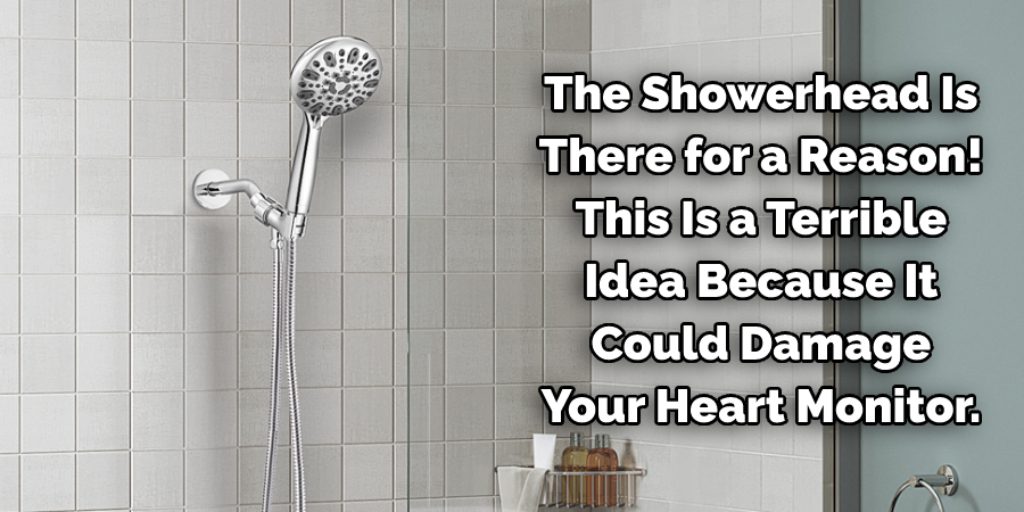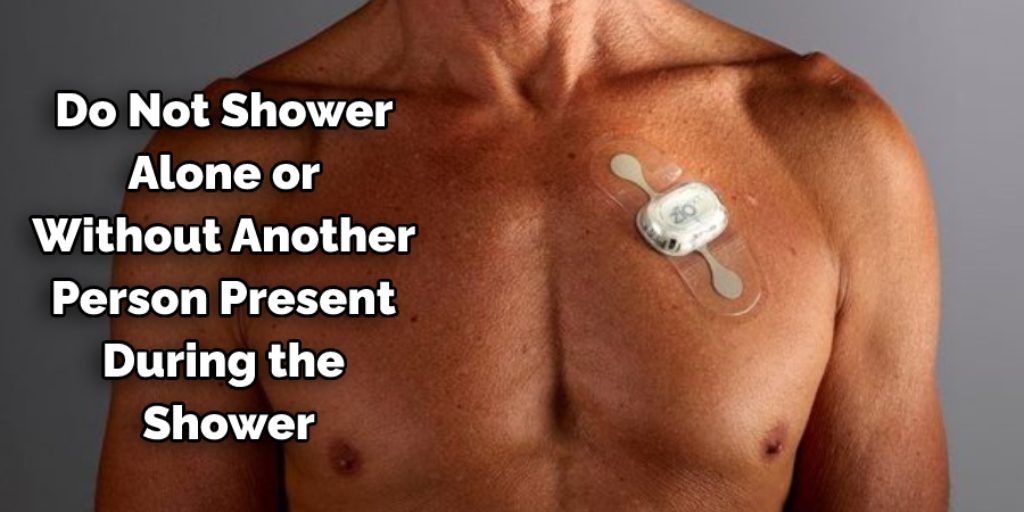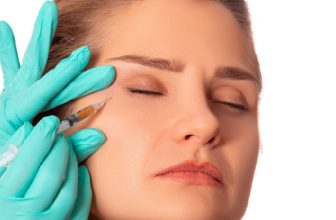How to Shower With a Heart Monitor
A shower is a place where many of us take a moment to relax and unwind. But for those with heart conditions, this can be a dangerous idea. To protect your health, you should avoid washing the chest area when showering.

By following these simple guidelines, you’ll be able to continue enjoying your daily routine while also protecting yourself from any risks that come with it! So, how do you know how to shower with a heart monitor? Well, luckily for all of us, some easy steps will help keep both our hearts healthy and happy in the process!
What is a Heart Monitor?
A heart monitor is a device that helps track your heart’s rhythm and activity. It records the electrical signals produced by your heart and displays them on a screen for you to see. This allows doctors to monitor their patient’s health closely and detect any potential problems early on.
Some common types of heart monitors include holters, event monitors, and implantable loop recorders. Holters are portable devices that continuously monitor your heart’s activity for 24 to 48 hours. Event monitors can be worn for up to a month and only record when the patient feels symptoms of an irregular heartbeat. Implantable loop recorders are small devices placed under the skin that continuously monitor the heart’s rhythm for up to three years.
Why is it Important to Protect Your Heart Monitor in the Shower?
Water and electronics don’t mix well, and this applies to heart monitors as well. Getting your heart monitor wet can damage the device or interfere with its readings. Therefore, it’s essential to keep your heart monitor dry at all times, especially when showering.
Moreover, wet skin can also interfere with the electrodes’ ability to pick up accurate readings from your heart. As a result, this could lead to false alarms or misinterpretation of data by healthcare professionals.
Showering with a Heart Monitor: Dos and Don’ts
Do Not Wash the Chest Area
The most important thing to remember when showering with a heart monitor is to avoid getting the chest area wet. Most heart monitors are not waterproof, and water can damage the device or interfere with its readings. It’s best to take a sponge bath instead of a full shower and focus on cleaning other areas of your body.
Protect the Monitor
If you need to take a shower, it’s essential to cover your heart monitor with plastic wrap or a waterproof bandage. This will protect the device from getting wet and ensure that it continues to function correctly. You can also use a shower chair and avoid any sudden movements to reduce the risk of water splashing onto the monitor.
Keep Your Shower Short
It’s best to keep your showers short when wearing a heart monitor. The longer you stay in hot water, the more likely it is that your monitor will get wet. Try to limit your shower time to 10-15 minutes and avoid taking baths or using hot tubs altogether.
Be Careful When Drying Off
When you’re done showering, be careful when drying off. Avoid rubbing the towel over the monitor area as this can cause friction and potentially damage the device. Instead, gently pat the area dry or use a hairdryer in a cool setting to speed up the drying process.
Things to Consider Before Showering With a Heart Monitor:
- Is your heart monitor waterproof? If not, take extra precautions to keep it dry.
- Are you wearing any loose clothing that could get caught on the electrodes or wires?
- Do you have any skin conditions that require special care when showering? Consult with your doctor for advice.
- Are you feeling any symptoms of an irregular heartbeat? If so, avoid showering until you have consulted with your doctor.
10 Ways on How to Shower With a Heart Monitor:
1. Use the Heart Monitor
Some people forget that they are wearing a heart monitor when they take an average shower. As long as the device is on your chest, you are good! The water will not damage it. When you are finished showering, take the device off immediately. You don’t want it to get wet by any splashing! But make sure you avoid washing the chest area while showering. It’s always best to consult with your doctor for specific instructions on showering with a heart monitor.
2. Rinse Your Hair with the Monitor On
This one works best if you have fine hair and lather with shampoo while taking a shower. Also, this works best if the shirt you’re wearing while showering is 100% cotton, and do not try this on a shirt with a high cotton/polyester blend because the water will seep through and damage your heart monitor. Because of this, many people prefer to rinse their hair separately while avoiding the chest area.

3. Use the Handrail
Do not be ashamed to use the handrails in your shower. They are there for a reason! If you have trouble maintaining balance because of weak leg muscles or just like extra stability, do not be afraid to grab that rail! Just make sure not to pull at any wires or accidentally hit your chest monitor while using it. It’s always best to take precautions, even if it takes a little bit longer.
4. Use Waterproof Bandages
Well, what if I don’t want to stick a band-aid on my chest? In an emergency, you can use waterproof bandages, but only in rare cases where you are showering for less than 10 minutes. If you shower longer or have sensitive skin, do not use waterproof bandages because they could come off and irritate your chest. If you do use a band-aid, make sure it’s one that is waterproof and medical grade.
5. Use a Shirt with a High Cotton/Polyester Blend
Many people have trouble showering while wearing a heart monitor if their shirt is cotton or has a high cotton blend. This is because water seeps through the fibers, gets into the heart monitor, and wreaks havoc on it. However, wearing a shirt with less than 25% polyester will not be an issue. The water will not be able to get through the fibers, which means no damage to your heart monitor!
6. Use a Waterproof Shirt
If you do not like the feel of wearing a t-shirt, you can opt to buy one that is made almost entirely out of polyurethane or another waterproof material. These shirts are specifically designed for people who need to wear heart monitors and regularly take showers, but you should still check the label to ensure it is safe to wash in a washing machine. When in doubt, hand wash and line dry. The last thing you want is to ruin your heart monitor by being careless!
7. Shampoo Your Head First
It would help if you shampooed your head first because that is where most of your hair is, and the shampoo will rinse off your body as you run water over yourself. This means that if you have shampoo residue on you when you wash your body, it will require more effort to get rid of. This means that you will be in the shower longer and increase the risk of getting your heart monitor wet. Shampooing first can prevent this.
8. Lather Your Arms First
When lathering yourself in the shower, begin with your arms. This is because most shower gels, soaps, and shampoo residue tend to accumulate on the lower half of the human body. If you lather your arms first, you won’t have to wash them several times to get rid of soap residue. This will reduce the time you spend in the shower and decrease the risk of getting your heart monitor wet.
9. Use the Shower Head to Rinse
Some people like to use shampoo or soap directly on their chest, but this is a terrible idea because it could damage your heart monitor. The showerhead is there for a reason! This way, you can avoid direct contact with anything that might interfere with your heart rate readings. Simply rinse your chest with the showerhead when it’s time to wash that area. You can continue to use the showerhead for other areas of your body as well.
10. Use Conditioner to Get Rid of Chlorine
If you take a lot of showers, then your hair will probably be exposed to chlorine from swimming pools regularly. If you have access to a conditioner, this would be a great time to use it because the water from the shower will rinse it off and wash away any excess chlorine that may have gotten onto your hair. This is a great way to keep your hair healthy, and it also ensures that you don’t have any chlorine on your skin when you’re wearing your heart monitor.
Following these tips on how to shower with a heart monitor can help you take a shower safely while wearing a heart monitor. Remember to always consult with your doctor for specific instructions, and don’t be afraid to ask questions. With proper care, you can continue living your life without any interruptions from the heart monitor! So go ahead and enjoy that refreshing shower without any worries.
Some Tips and Tricks:
- To keep the monitor in place, use a removable shower strap.
- Alternate monitor positions to prevent water damage (e.g., see Figure 1 for positions on the back, chest and arm).
- Place monitor outside of direct spray or water flow whenever possible.
- Do not submerge the monitor in water.
- Keep the monitor away from sharp objects and hot surfaces since this may damage the monitor.
- Do not place the monitor on or on a wooden surface, and prevent direct contact with wood and all types of natural material.
- If you’re feeling adventurous, you can try using a waterproof case specifically designed for heart monitors.
- Always read the instructions manual before using your particular heart monitor in the shower.
- Consider investing in a water-resistant or waterproof heart monitor if you frequently take showers while wearing it.
- If your heart monitor does get wet, turn it off and remove the battery immediately. Gently dry it with a towel and let it air dry.
- If you notice any issues with your heart monitor after showering, consult your doctor or the manufacturer for further guidance.
- Remember to regularly clean and maintain your heart monitor according to the manufacturer’s instructions.
- If you have long hair, consider tying it back with the heart monitor to prevent it from getting tangled.
- Use a mild, pH-balanced soap or shower gel that is safe for sensitive skin to avoid irritation when washing around the heart monitor area.
- Lastly, be mindful and gentle when handling your heart monitor while in the shower to prevent any accidental damage. Overall, the key is to be cautious and take proper care of your heart monitor while showering so that it can continue to accurately monitor your heart health. So go ahead, follow these tips and tricks, and enjoy a stress-free shower with your heart monitor!
Some Precautions and Safety Measures:
- Do not shower alone or without another person present during the shower.
- Avoid direct spray or water flow whenever possible to prevent electrical shock/electrocution hazards.
- The monitor should only be used by one person, as this may damage the monitor or cause malfunctions.
- Only use the tested and adequately working shower head when in the shower to reduce hazards during electrical shock.
- Do not use water that is too hot or too cold, which may damage the monitor or malfunction.
- Never touch the power and interface cable with wet hands, as this may damage the monitor or cause malfunctions.
- Do not share your monitor with anyone else. Your heart rate and personal health information are only to be used by you.
- Follow all standard safety procedures to avoid electrical shock/electrocution hazards.
- If you experience any discomfort or abnormal readings while using the monitor, stop using it and consult your doctor immediately.
- Ensure that all cords and cables are secure and out of the way to prevent tripping hazards.
- Keep an eye on the battery life of your heart monitor to avoid it turning off mid-shower or during a workout.
- If you plan on taking an extended shower, consider setting an alarm to remind yourself to check the battery life of your monitor.
- Avoid using harsh chemicals on your body while wearing the heart monitor as it may cause damage and affect its accuracy.
- Consult with your doctor if you have any concerns about using a heart monitor in the shower, especially if you have any underlying medical conditions.
- Always take precautions and follow instructions when using electronic devices near water to avoid potential hazards.
- Lastly, remember to always prioritize your safety and well-being while using a heart monitor in the shower or any other activity. These precautions may seem like a lot, but they are necessary for ensuring your safety and the proper functioning of your heart monitor.

Frequently Asked Questions:
Q: Can I Take a Bath With My Heart Monitor?
A: It is not recommended to take a bath with your heart monitor as this may damage the device. Stick to taking showers instead. You can also consult your doctor for more information regarding bathing with a heart monitor. If your doctor approves, make sure to follow the same precautions and safety measures mentioned above.
Q: How Do I Take Care of My Heart Monitor After Showering?
A: After showering, gently pat dry the area around the monitor and avoid rubbing or touching it too much. If your monitor has a removable strap, take it off and wash it separately. Make sure to clean any sweat or residue from the sensor pads as well. Finally, store your heart monitor in a cool, dry place.
Q: Can I Wear My Heart Monitor While Swimming?
A: It is not recommended to wear your heart monitor while swimming as it may not be waterproof and could get damaged. Suppose you need to track your heart rate while swimming; consider using a waterproof fitness tracker instead. Consult your doctor for more information on tracking your heart rate during physical activities.
Q: How Often Should I Replace My Heart Monitor?
A: It is best to consult your doctor for specific recommendations on when to replace your heart monitor. However, in general, most monitors have a lifespan of 1-3 years and may need to be replaced if they start malfunctioning or giving inaccurate readings. Regularly check the battery life and condition of your monitor as well.
Q: Can I Shower With a Heart Monitor After Surgery?
A: It is best to consult your doctor for specific recommendations after surgery. In some cases, they may advise you to wait a certain amount of time before showering with your heart monitor again. Follow their instructions carefully and make sure to follow all safety precautions mentioned above. Overall, it is important to prioritize your health and listen to your doctor’s advice to ensure the proper care and maintenance of your heart monitor.
Conclusion:
If you want to know how your heart is doing while taking a shower, there are some options for monitoring. These devices range in price and capability, but they all provide the same information about your pulse. Of course, you want to make sure that all of the sensors are in contact with the skin from your chest down into your waistband and up under armpits if possible.
If a sensor ever becomes loose or falls off, please stop using the device until you can replace it. With these simple techniques, you should be ready to shower with relative ease while wearing a heart monitor! If you have any other suggestions or questions about how to shower with a heart monitor, please feel free to leave them in the comments section below.




